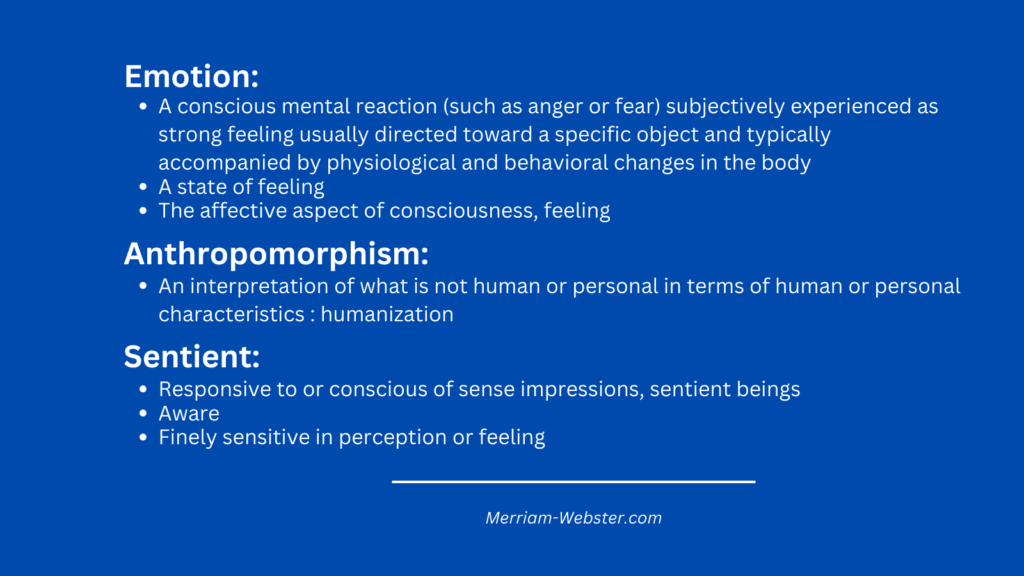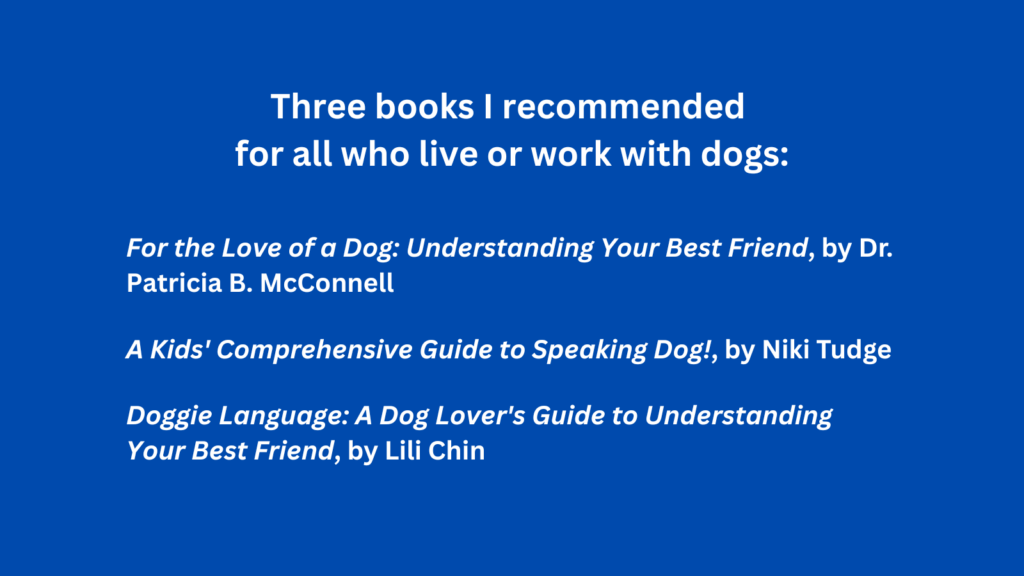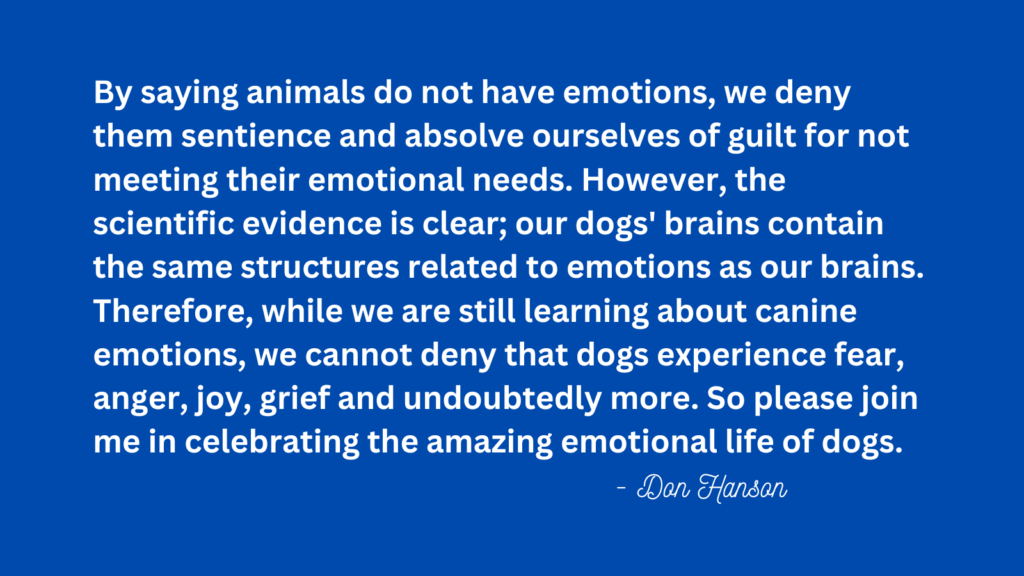Barks Blog
Pets, Emotions and Anthropomorphism
by Don Hanson
Emotions are complicated and messy. So much so that as a youngster watching Star Trek in the 1960s, I was attracted to the Vulcan ethos of suppressing all emotion and replacing it with logic. However, I eventually learned that without emotion, we are devoid of joy, gratitude, serenity, interest, hope, pride, amusement, inspiration, awe and love. But, unfortunately, the price for those positive feelings is negative emotions such as anger, emptiness, frustration, inadequacy, helplessness, fear, guilt, loneliness, depression, feeling overwhelmed, resentment, failure, sadness and jealousy. The fact is, emotions are part of our life as sentient beings. Notice I did not say emotions make us human, because to do so would be incorrect.

Anthropomorphism is attributing “human” characteristics to other animals. Many believe it is a severely flawed concept that should be tossed on the scrap heap of history with other nonsense like dominance. I agree.
René Descartes (1596–1650) is considered the founder of modern Western philosophy and was the mathematician who developed the Cartesian coordinate system used in analytic geometry. He was also a devout Christian. The first principle of his philosophy was cogito, ergo sum, or “I think, therefore I am.” He believed that nonhuman animals were nothing more than biological machines. They were incapable of thinking or having emotions and could not feel pain. He also thought that animals had no soul. These beliefs were how he justified dissecting live animals in his experiments. Some biographies of Descartes claim his first experiment with a live dog involved nailing the dog, alive, to a board and cutting it open.

One of my favorite books on emotions and dogs is For the Love of a Dog: Understanding Emotion in You and Your Best Friend, by Dr. Patricia B. McConnell. It is the book I recommend as mandatory reading for anyone with a dog or anyone who works with dogs.
Dr. McConnell was one of the first scientists to write about emotions in dogs. In her book, she discusses the history of human thought on the topic of emotions in animals and brings us up to date with what we know now. She also talks about the remarkable similarities in how dogs and people express feelings: “It’s no coincidence that highly social animals like people and dogs have exceptionally expressive faces.”
It is interesting to note that not all old scientists got it wrong. For example, Charles Darwin made observations similar to those of Dr. McConnell in 1897 in his book, The Expression of the Emotions in Man and Animals.

By saying animals do not have emotions, we deny them sentience and absolve ourselves of guilt for not meeting their emotional needs. However, the scientific evidence is clear—our dogs’ brains contain the same structures related to emotions as our brains. Therefore, while we are still learning about canine emotions, we cannot deny they experience fear, anger, joy, grief and undoubtedly more. So please join me in celebrating the rich emotional life of our dogs.
I believe that anyone who insists our pets do not experience emotions will be unlikely to provide a pet with the quality of life it deserves.
Recommended Resources
Online
Darwin, C. (1897). The Expression of the Emotions in Man and Animals. Authorized edition. Retrieved January 11, 2023 from https://www.academia.edu/35968177/THE_EXPRESSION_OF_THE_EMOTIONS_IN_MAN_AND_ANIMALS
International School for Canine Psychology and Behaviour. (n.d.). Emotional health & dogs. Retrieved January 11, 2023 from https://www.theiscp.com/post/emotional-health-dogs
Sheridan, D. (2022). Let’s talk about our dogs’ feelings. Pets and Their People. Retrieved January 11, 2023 from https://petsandtheirpeople.education/articles/lets-talk-about-our-dogs-feelings/
Books
Bekoff, M. (2002). Minding Animals—Awareness, Emotions & Heart. Oxford University Press.
Chin, L. (2020). Doggie Language: A Dog Lover’s Guide to Understanding Your Best Friend. Summerdale.
Damasio, A. (1994). Descartes’ Error: Emotion, Reason, and the Human Brain. Penguin Books.
de Waal, F. (2018). Mama’s Last Hug: Animal Emotions and What They Tell Us About Ourselves. W. W. Norton.
McConnell, P. B. (2006). For the Love of a Dog: Understanding Emotion in You and Your Best Friend. Ballantine Books.
Panksepp, J. (2004). Affective Neuroscience: The Foundations of Human and Animal Emotions. Series in Affective Science. Oxford University Press.
Rugass, T. (2006). On Talking Terms With Dogs: Calming Signals. Dogwise Publishing.
Safina, C. (2015). Beyond Words: What Animals Think and Feel. Henry Holt & Company.
Tudge, N. (2017). A Kids’ Comprehensive Guide to Speaking Dog!. Joanne Tudge.
Don Hanson lives in Bangor, Maine, where he is the co-owner of the Green Acres Kennel Shop and the founder of ForceFreePets.com, an online educational resource for people with dogs and cats. He is a professional canine behavior consultant (PCBC-A) accredited by the Pet Professional Accreditation Board (PPAB) and a Bach Foundation Registered Animal Practitioner (BFRAP). Don is a member of the Pet Professional Guild (PPG), serving on the board of directors and Steering Committee, and chairing the Advocacy Division. He is also a founding director of Pet Industry Advocacy International (PIAI). In addition, Don produces and co-hosts The Woof Meow Show podcast. The opinions in this article are those of Don Hanson.

